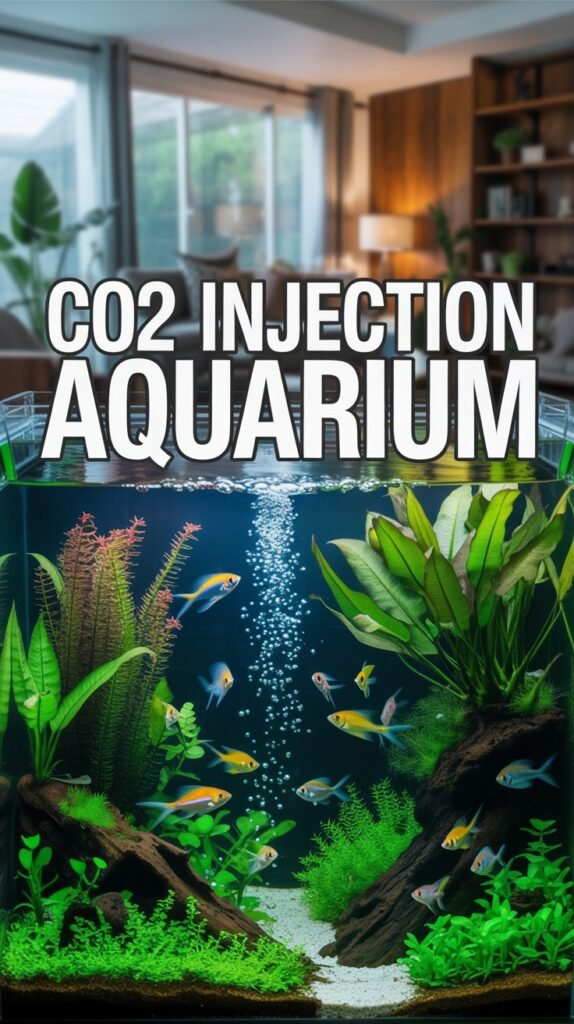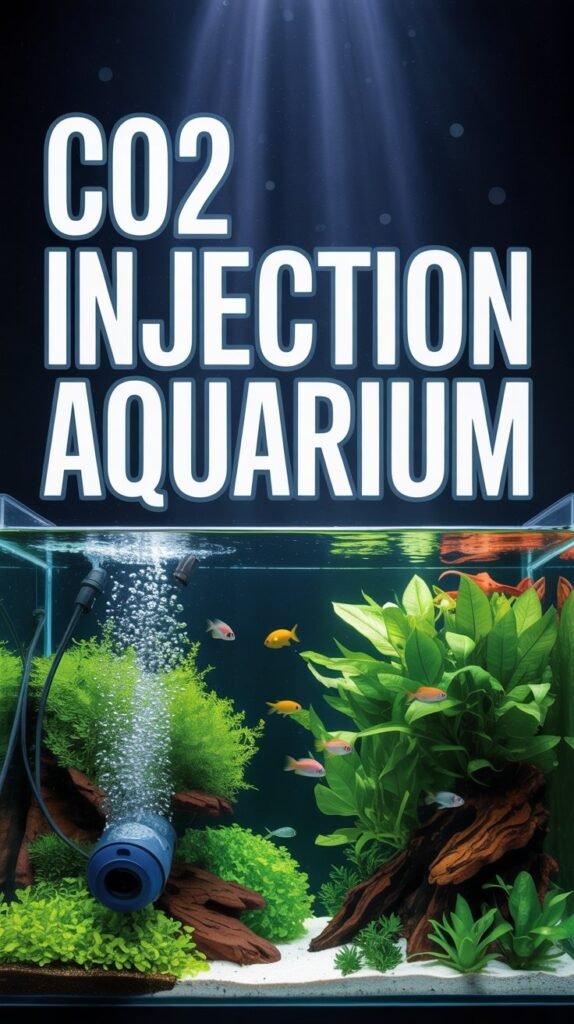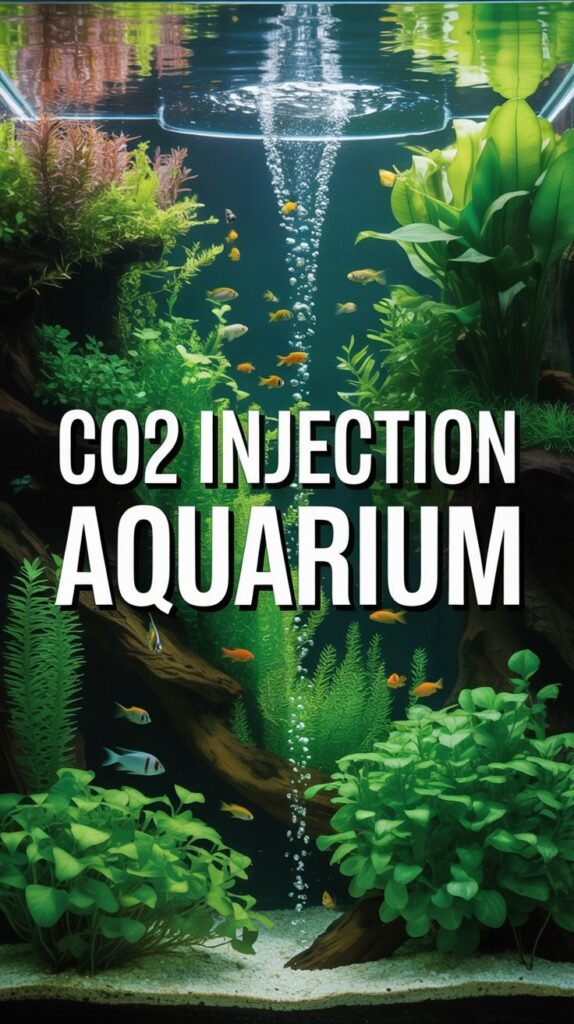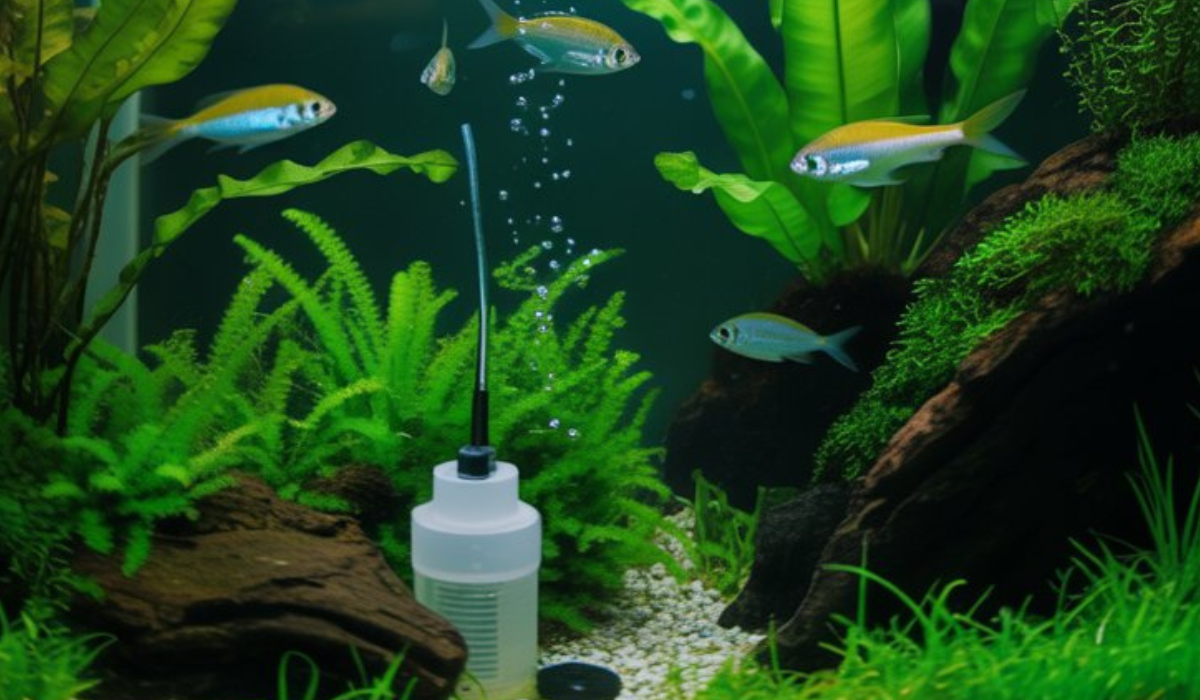Maintaining a thriving planted aquarium is both an art and a science. Among all the essential factors that ensure lush, vibrant aquatic plant growth, CO2 injection stands out as one of the most impactful. Carbon dioxide (CO2) plays a critical role in photosynthesis, allowing plants to grow faster, healthier, and more colorful.
If you’ve ever wondered why some aquariums look like underwater jungles while others struggle with stunted plants or algae overgrowth, the answer often lies in CO2 management. This comprehensive guide will explain everything you need to know about CO2 injection in aquariums — from why it’s important, how it works, what equipment you need, and how to set it up safely.
What is CO2 Injection in an Aquarium?
CO2 injection refers to the process of adding controlled amounts of carbon dioxide gas into your aquarium water to enhance plant growth. In natural bodies of water, CO2 is available through the respiration of fish, decomposition of organic matter, and exchange with the atmosphere.
However, in closed aquariums, especially heavily planted ones, the natural CO2 levels are often insufficient for healthy photosynthesis. That’s where CO2 injection systems come in — they supplement the carbon dioxide plants need to flourish.
Why CO2 is Important for Aquarium Plants

CO2 is a fundamental building block in the process of photosynthesis, which allows plants to convert light energy and carbon into oxygen and glucose. Here’s a breakdown of the process:
Photosynthesis formula:
6CO₂ + 6H₂O + light → C₆H₁₂O₆ + 6O₂
When plants have sufficient CO2, light, and nutrients, they grow rapidly, develop vivid colors, and outcompete algae. Without CO2, plants grow weakly, leaves melt, and algae start to dominate the tank.
Key Benefits of CO2 Injection
- Accelerated Plant Growth: Plants grow denser and more vibrant.
- Improved Aesthetics: Rich green foliage and colorful leaves.
- Reduced Algae Growth: Healthy plants consume excess nutrients that algae rely on.
- Healthier Ecosystem: Stable CO2 levels promote oxygen production, benefiting fish.
- Better Aquascaping Control: Helps achieve professional-looking aquascapes like the “Nature Aquarium” style popularized by Takashi Amano.
Natural CO2 vs. Injected CO2
In a typical aquarium, fish respiration and organic waste produce small amounts of CO2. While this may be enough for low-tech setups (with slow-growing plants like Java Fern or Anubias), it’s insufficient for high-light or densely planted tanks.
Low-Tech Tank:
- No CO2 injection
- Low light intensity
- Slow-growing plants
- Minimal maintenance
High-Tech Tank:
- CO2 injection required
- High-intensity lighting
- Fast-growing plants (like Rotala, Ludwigia, Glossostigma)
- Regular fertilization and monitoring
If you aim for a lush, fast-growing aquascape, CO2 injection becomes essential.
Types of CO2 Injection Systems
There are several methods to introduce CO2 into your aquarium, ranging from DIY setups to advanced pressurized systems. Let’s explore the most common options:
1. DIY CO2 System (Yeast-Based)
This budget-friendly method uses a mixture of sugar, water, and yeast to produce CO2 through fermentation.
Pros:
- Low-cost and easy to build
- Suitable for small tanks (under 20 gallons)
Cons:
- Unstable CO2 output
- Requires frequent maintenance
- Difficult to control CO2 levels
Best for: Beginners or hobbyists with nano aquariums.
2. Pressurized CO2 System
This is the most reliable and efficient CO2 injection method. It uses a compressed CO2 cylinder connected to a regulator, solenoid valve, diffuser, and bubble counter.
Components:
- CO2 Cylinder: Stores compressed CO2 gas.
- Regulator: Controls the gas pressure and flow rate.
- Solenoid Valve: Allows CO2 to turn on/off automatically (usually with a timer).
- Bubble Counter: Helps you measure CO2 output visually.
- Diffuser/Atomizer: Breaks CO2 into fine bubbles for better dissolution.
- Check Valve: Prevents water from flowing back into the system.
Pros:
- Consistent and controllable CO2 output
- Suitable for any tank size
- Long-lasting and efficient
Cons:
- Higher initial cost
- Requires periodic refilling of CO2 cylinders
Best for: Medium to large aquariums or serious aquascapers.
3. CO2 Tablets or Liquid Carbon
If you’re not ready for full CO2 injection, liquid carbon products like Seachem Excel or CO2 tablets can be alternatives. They provide a carbon source that plants can use.
Pros:
- Easy to use
- No equipment needed
Cons:
- Less effective than gas injection
- May harm certain plant species if overdosed
Best for: Low-tech planted tanks or beginners testing CO2 supplementation.
How to Set Up a CO2 Injection System

Setting up a CO2 system might seem complex, but with a little patience, it’s straightforward. Here’s a step-by-step guide:
Step 1: Assemble the Equipment
You’ll need:
- CO2 cylinder
- Regulator with solenoid valve
- Bubble counter
- CO2 tubing
- Diffuser or reactor
- Check valve
- Timer (optional)
Step 2: Install the Regulator
Attach the regulator to the CO2 cylinder. Ensure it’s tightly secured to avoid leaks. Always do this in a well-ventilated area.
Step 3: Connect the Tubing
Attach the tubing from the regulator to the bubble counter, then to the diffuser or reactor placed inside the aquarium.
Step 4: Set Bubble Rate
Start with 1 bubble per second (BPS) for every 20 gallons of water. Adjust gradually based on your plant and fish response.
Step 5: Sync with Light Cycle
Use a timer to turn CO2 injection on 1 hour before lights and off 1 hour before lights out. Plants only use CO2 when the lights are on.
Step 6: Monitor CO2 Levels
Use a drop checker with bromothymol blue solution:
- Green: Optimal CO2 level (20–30 ppm)
- Blue: Too little CO2
- Yellow: Too much CO2 (can harm fish)
Optimizing CO2 Injection
For best results, balance CO2 with light and nutrients. Here are essential tips:
1. Maintain Consistent CO2 Levels
Fluctuations cause algae blooms and plant stress. Ensure your CO2 is steady throughout the photoperiod.
2. Improve CO2 Diffusion
Use atomizers, inline diffusers, or reactors for efficient gas dissolution.
3. Balance Lighting
More light increases plants’ CO2 demand. If CO2 is low but light is high, algae will thrive.
4. Add Proper Fertilization
CO2 alone isn’t enough — plants also need macronutrients (N, P, K) and micronutrients (iron, magnesium, etc.). Use an EI (Estimative Index) or all-in-one fertilizer schedule.
5. Ensure Good Water Flow
Distribute CO2 evenly by positioning the diffuser near the filter outlet or using a circulation pump.
Signs of CO2 Deficiency
If your aquarium plants aren’t thriving despite good lighting, you might be facing a CO2 shortage. Common signs include:
- Slow or stunted plant growth
- Algae buildup (especially hair algae)
- Yellow or transparent leaves
- Plants not pearling (releasing oxygen bubbles)
- Fish gasping at the surface (inconsistent CO2 levels)
CO2 Injection Safety Tips

While CO2 is beneficial, excessive amounts can harm fish and invertebrates. Always prioritize safety with these guidelines:
- Monitor Levels: Keep CO2 between 20–30 ppm.
- Use a Drop Checker: Provides a visual indication of CO2 concentration.
- Check for Leaks: Use soapy water on connections to detect leaks.
- Turn Off at Night: Plants don’t need CO2 in the dark — using a solenoid saves gas and prevents suffocation.
- Ensure Aeration: A gentle surface ripple ensures oxygen exchange.
Common CO2 Injection Problems and Solutions
| Problem | Cause | Solution |
|---|---|---|
| Fish gasping for air | Too much CO2 | Reduce bubble rate, increase surface agitation |
| Algae outbreak | CO2/light imbalance | Adjust CO2 or reduce lighting intensity |
| Diffuser clogged | Buildup or dirt | Clean diffuser weekly |
| CO2 cylinder empty | Normal usage | Refill at local gas supplier |
| Drop checker stays blue | Low CO2 injection | Increase bubble rate gradually |
CO2 Injection for Different Tank Sizes
Nano Tanks (Under 20 Gallons)
- DIY or small pressurized system
- Bubble rate: 1–2 BPS
- Use fine diffusers for microbubbles
Medium Tanks (20–50 Gallons)
- Pressurized CO2 recommended
- Bubble rate: 2–3 BPS
- Inline diffuser or atomizer for even distribution
Large Tanks (50+ Gallons)
- Full pressurized system
- Use CO2 reactor for efficient dissolution
- High water flow to distribute CO2 evenly
CO2 and Fish Compatibility
CO2 is safe for fish when properly controlled. Most tropical species thrive in CO2-injected tanks as long as oxygen levels remain sufficient.
Tips:
- Avoid over-injecting CO2
- Maintain good surface agitation
- Observe fish behavior daily
Fish gasping at the surface is a warning sign — lower CO2 immediately and increase aeration.
CO2 Injection and Algae Control
Healthy plant growth is the best defense against algae. When plants get enough CO2, they outcompete algae for nutrients and light. However, CO2 imbalance can trigger issues like:
- Black Beard Algae (BBA) from fluctuating CO2
- Green Dust Algae (GDA) from low CO2 levels
To prevent this:
- Keep CO2 stable daily
- Clean glass and filters regularly
- Balance nutrient dosing and lighting
Cost of Setting Up a CO2 Injection System
| Component | Estimated Cost (USD) |
|---|---|
| CO2 Cylinder (5 lb) | $50–70 |
| Regulator with Solenoid | $60–100 |
| Diffuser | $10–25 |
| Bubble Counter & Check Valve | $10 |
| CO2 Tubing | $5–10 |
| Drop Checker | $10–15 |
| Refill (5 lb tank) | $10–20 |
Total Setup Cost: Around $120–200 for a quality pressurized system.
Although it’s an upfront investment, the results — faster plant growth and a visually stunning aquascape — are well worth it.
Maintenance of CO2 Injection System
To keep your system efficient:
- Check connections weekly for leaks.
- Clean diffuser to prevent clogging.
- Replace CO2 cylinder when pressure drops.
- Monitor drop checker to ensure consistent CO2 levels.
- Inspect tubing for cracks or wear.
Regular maintenance ensures optimal performance and prevents costly damage.
Best Practices for Long-Term CO2 Success
- Use consistent schedules (timer control).
- Match CO2 injection rate with plant density and light intensity.
- Perform weekly water changes (30–50%) to remove excess nutrients.
- Observe your plants — they’re the best CO2 indicators.
- Avoid sudden changes; adjust CO2 gradually.
Conclusion
A well-balanced CO2 injection system can completely transform your planted aquarium. By providing plants with the carbon they need for photosynthesis, you’ll experience faster growth, richer colors, and a more stable aquatic ecosystem.
While it requires an initial investment and learning curve, the long-term benefits — both aesthetic and ecological — make it one of the best upgrades for any aquascaping enthusiast.
Remember, balance is key: CO2, light, and nutrients must work in harmony. Mastering this balance will help you create the lush, underwater paradise you’ve always dreamed of.
FAQs About CO2 Injection Aquarium
1. Is CO2 injection necessary for all planted aquariums?
No. Low-tech tanks with slow-growing plants can thrive without CO2. However, for high-light or densely planted tanks, CO2 injection significantly improves plant health and growth.
2. Can too much CO2 kill fish?
Yes. Excessive CO2 reduces oxygen levels, causing fish to suffocate. Always monitor levels using a drop checker and keep CO2 around 20–30 ppm.
3. How long does a 5 lb CO2 tank last?
Typically 2–3 months for a 30–50 gallon tank running 8 hours per day, depending on bubble rate and usage.
4. What’s the best time to inject CO2?
Start injecting 1 hour before lights turn on and stop 1 hour before lights go off. This ensures plants have CO2 available during photosynthesis.
5. Can I use DIY CO2 for large tanks?
Not recommended. DIY systems are unstable and suitable only for small tanks under 20 gallons.
6. What’s the ideal CO2 level for plants?
Aim for 20–30 ppm for optimal growth without harming fish.
7. Do I still need fertilizers with CO2 injection?
Yes. CO2 provides carbon, but plants also need nutrients like nitrogen, phosphorus, potassium, and trace elements for complete growth.
8. How do I know if my plants are getting enough CO2?
Healthy plants show pearling (tiny oxygen bubbles) and vibrant coloration. If leaves turn yellow or algae appears, CO2 may be insufficient.
9. What happens if CO2 stops suddenly?
If CO2 is cut off during the light period, plants may experience stress and algae may develop due to imbalance. Restore CO2 gradually.
10. Is CO2 injection worth it?
Absolutely! It enhances plant health, prevents algae, and creates a stunning, natural-looking aquascape — making it a top investment for aquarium hobbyists.

